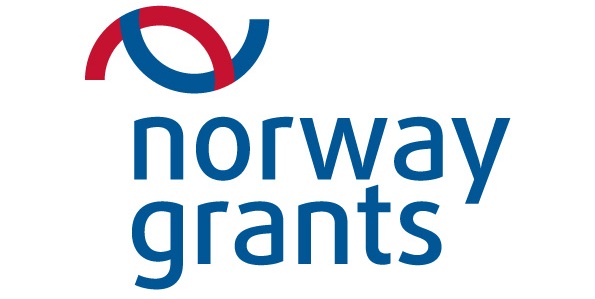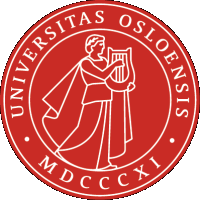 |
News
20.02.2018.
Published project articles:
Kalniņš, M., Bērziņš, V., Zagorska, I. (2017) Krama
apstrādes tehnoloģiju terminoloģija.
Latvijas Vēstures Institūta Žurnāls, nr. 2 (103): 5.–26.
lpp. (https://www.lvi.lu.lv/lv/LVIZ_2017_files/2numurs/M_Kalnins_V_Berzins_I_Zagorska_Krama_LVIZ_2017_2.pdf)
Articles accepted for
publication:
Damlien, H., Berg-Hansen, I.M., Zagorska, I., Kalniņš, M.,
Nielsen,
S.V., Koxvold, L.U., Bērziņš, V., Schülke, A. A
Technological
crossroads: exploring diversity in the pressure blade technology of
Mesolithic Latvia. Oxford Journal of
Archaeology.
Rundberget, B., Vasks, A., Larsen, J.H., Bebre,
V., Brūzis, R., Doniņa,
I., Gundersen, I.M., Vīksna, A. The bloomery in Latvia
– Iron Age and
medieval technologies in a comparative study. Historical Metallurgy.
Jakovļeva, M., Auziņa, D., Brūzis, R., Gundersen,
I.M., Rundberget,
B., Bebre, V., Doniņa, I., Kļava, V., Straube, G.,
Bērziņš, V., Vīksna,
A., Actiņš, A., Meija, R., Popovs, K., Upmalis, R., Parfentev,
A. Gone
to smelt iron in Courland: technology transfer in the development of an
early modern industry. Postmedieval
Archaeology.
Kļava, V., Straube, G., Siliņa-Piņķe, R., Guščika, E.,
Bērziņš, V.,
Urtāns, U., Upmalis, R., Bērziņš, D. Evidence of 16th- and
17th-century
iron production and ironworking in Vidzeme (the example of Ropaži
manor): an interdisciplinary approach. Journal of Baltic Studies.
11.-13.10.2017
With the support of the Bilateral Fund,
a group of project experts from the University of Latvia -
V.Bērziņš,
M.Kalniņš and I.Zagorska - made a three-day visit to the Museum
of Cultural History, University of Oslo, to meet project
experts I.M.Berg-Hansen, H.Damlien and A.Schülke. Discussion
focussed on questions relating to the continuation of joint research on
the Stone Age and the provision of funding for such research. A field
trip was made to visit Stone Age sites in the environs of Oslo.
25.10.2016.
An international
conference on the project theme "Flint and iron in the course of
history: technology transfer in the processing of mineral resources in
earlier times" will be held at the Small Hall of the University
of Latvia (Raiņa bulvāris 19, Riga) on 25 October. This is a public
event, all are cordially invited. Conference languages: Latvian,
English.
Conference
programme
13.08.2016.
Iron produced in
experiment using 10th-century methods
In the course of the experiment carried out in
Ventspils in the frame of the project, using a reconstruction of a
10th-century smelting furnace as excavated at Asote Hill-Fort, a small
amount of iron was obtained from Latvian bog iron ore. The experiment
was conducted by the experienced Norwegian iron production specialist
T. Haraldsen, the project
experts A. Vijups, B. Rundberget, I. M. Gundersen, J. H. Larsen, M.
Kalniņš and the "veteran" of previous years' experiments E.
Sviklis.
Most importantly, through the collaboration with
the Norwegian specialists a clearer picture was obtained of the
conditions that need to be observed in building and successfully
operating this kind of 10th-century smelting furnace. The
experience obtained in the course of the experiment gives a better
understanding of the technical characteristics of the iron production
process used in ancient times in present-day Latvia and permits clearer
interpretation of the archaeological evidence.
Video
of the experiment (project Facebook
profile)
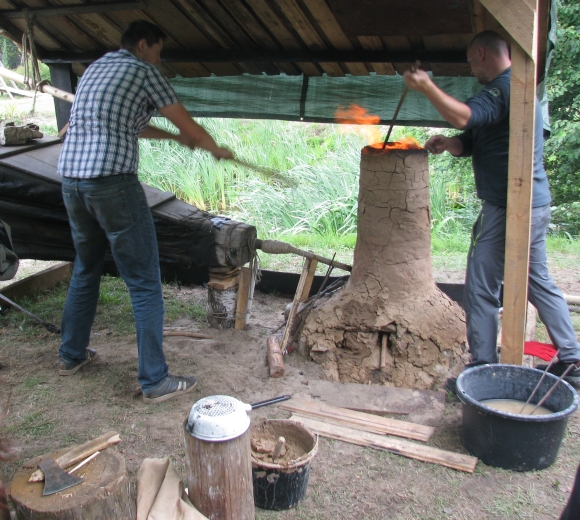
11.08.2016.
Preparing for an iron
production experiment in Ventspils
An experiment will be held at the Seaside Open-Air
Museum in Ventspils on 13 August with the aim of obtaining iron
from bog ore. For the purposes of the experiement a replica of a
Late Iron Age bloomery furnace has been built, corresponding to the
remains of a furnace from the 10th century excavated at Asote
Hill Fort in 1951. In the course of the experiment, bog iron ore
(limonite) from the Kurzeme region will be roasted on a hearth and then
the process of iron reduction will be performed in the replica furnace,
using bellows for oxygen supply. The experiment will be conducted by
leading specialists in iron production research from Latvia and Norway.
Information
about this event on our Facebook
profile.
11.08.2016.
Excavation of the "Asari" ironworks site
From 25 July up to 19 August a team of archaeologists and students from
the University of Latvia, in collaboration with Norwegian specialists,
is excavating the 17th-century ironworks of the Duchy of Courland
located at Asari in Vecumnieki County, Latvia. This is the
first archaeological excavation ever conducted at an ironworking
site in the former duchy.
The ironworks at Asari operated in the second half
of the 17th century. Like the other ironworks of this time, it was
water-powered. The Zvirzde River was dammed, the water diverted into
channels, driving the furnace bellows and mechanical hammers by means
of water-wheels. The ironworks is mentioned in 17th-century records,
but the written sources do not provide clear information about the
technologies used or the structures of the ironworks. Only
archaeological excavation can shed light on these issues. The Asari
ironworks was not one of the largest sites of this kind. Rather, it was
selected for archaeological investigation because it is a relatively
compact site, little affected by later activities; hence, it should be
easier to interpret.
The excavation is focusing mainly on the furnace site. As
the layers of rubble are gradually removed, massive concretions of iron
and slag are being revealed, of the kind that accumulated at the base
of the furnace, along with dolomite stone used for the furnace
structure. Evidence of the products of the ironworks has also come to
light: such as a cannonball and an iron bar. Just beside the furnace
site is a dolomite quarry that provided building materials. In the
course of the excavation, samples of slag, ore and iron objects will be
taken for analysis, in order obtain more precise informatioin about the
iron smelting and processing activities that took place on the site.
The ironworks in the former Duchy of Courland
represent an unusual historical phenomenon in Europe, reflecting the
desire of the dukes to develop production, even though the natural
conditions were not particularly favourable. In neighbouring Sweden,
iron was produced in large quantities from ore mined underground; on
the other hand, the Duchy of Courland had no such resources, and so bog
iron ore was the main raw material for ironmaking.
The excavation is being directed by Rūdolfs Brūzis,
researcher at the Institute of Latvian History, University of Latvia,
with a team of professional archaeologists, including Ingar
Mørkestøl Gundersen of the Museum of Cultural History,
University of Oslo, and students from the Faculty of History and
Philosophy, University of Latvia.
Visitors are welcome on the excavation open
day, 12 August (see our Facebook
profile).
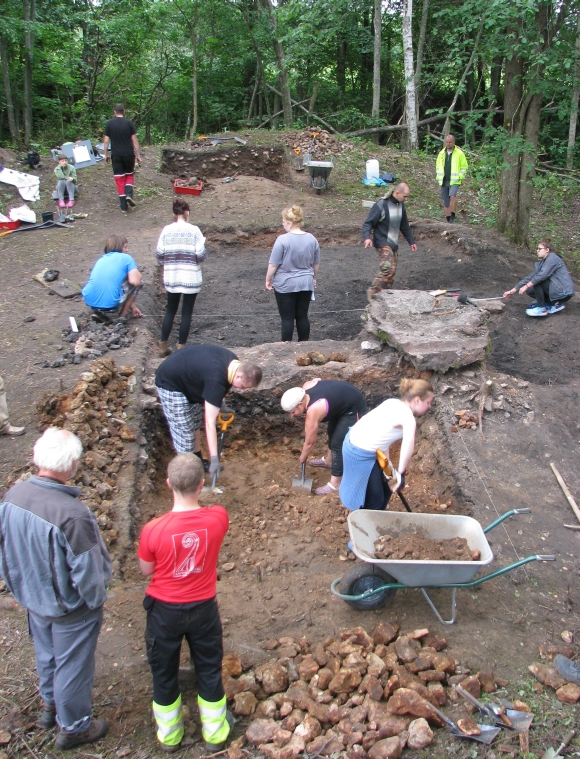
11.05.2016
Site for ironworks excavation selected: "Asari" in Vecumnieki
County
Based on the results of the survey work, the site for archaeological
excavation from 25 July to 19 August has been chosen. This is the Asari
ironworks site (Vecumnieki County), which relates to the extensive
Baldone ironworks complex. The survey indicated that the archaeological
remains of the manufactory are likely to be relatively well preserved,
and moreover they are restricted to a compact area.
In preparation for the excavation, a team of
student assistants has been recruited from the Faculty of History and
Philosophy of the University of Latvia. They have been introduced to
the objectives of the work and trained in using the surveying equipment
to be employed in the excavation.
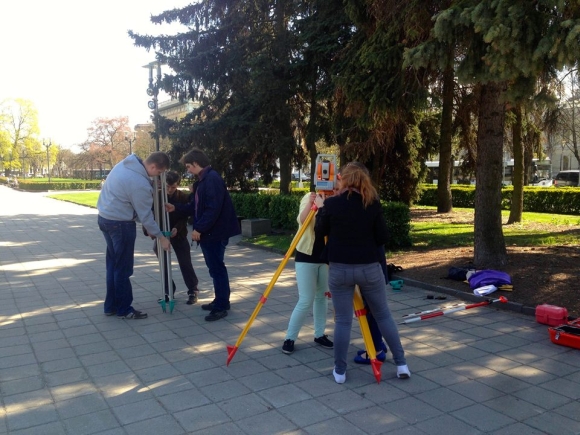 Students training
in the use of surveying equipment. Students training
in the use of surveying equipment.
28.04.2016.
Paper on research into iron production at a conference on
archaeological and anthropological research
At a research meeting held by the Institute of Latvian History,
University of Latvia under the title "Archaeological and
anthropological research in Latvia in 2014 and 2015", Dita Auziņa
presented the paper "Research on iron prodcution technologies in the
frame of the TechTrans
project".
04-14.04, 25.04-06.05.2016
Research by Norwegian specialists on Stone Age lithic technology in
present-day Latvia
Inger Maria Berg-Hansen and Hege Damlien, lithic technology
specialists from the University of Oslo - Museum of Cultural History,
in
collaboration with experts from the Latvian side, Ilga Zagorska, Mārcis
Kalniņš and Valdis Bērziņš, have been analysing Stone Age
lithic collections from Latvia, most of which are kept at the National
History Museum of Latvia. Attention has focussed mainly on the
cores from which blades were detached, as well as on the blades
themselves, identifying diagonistic features that indicate the use of
specific processing methods and techniques.
An extensive study was carried out of the lithic
collections from sites from the very end of the Palaeolithic, marking
the earliest period of habitation in Latvia, as well as those
from the Mesolithic, when different lithic technologies appeared.
The work was undertaken in the course of two visits
to Latvia. At the beginning of the first visit, the Nowegian
specialists presented their methodology to the small group of Latvian
archaeologists engaged in research relating to lithics. Informal
teaching sessions were also conducted. The leader of the project work
package, Almut Schülke, visited Riga for a shorter period in
order to take part in the analytical work. During the time of her visit
the project experts discussed the further course of cooperation, in
addition to which they travelled to the Salaspils Laukskolas site
(Salaspils County) and the Zvejnieki complex of sites (Burtnieki
County), which have provided two of the most important lithic
collections under study.
A very large corpus of data was obtained in the
course of the study. Analysis of this material in the further course of
the project will provide a clearer picture of the development of lithic
technology in present-day Latvia during the Stone Age. It is clear
already at this stage that the results will provide an important
addtion to current concepts regarding the transfer of technology during
the Stone Age in Northern Europe.
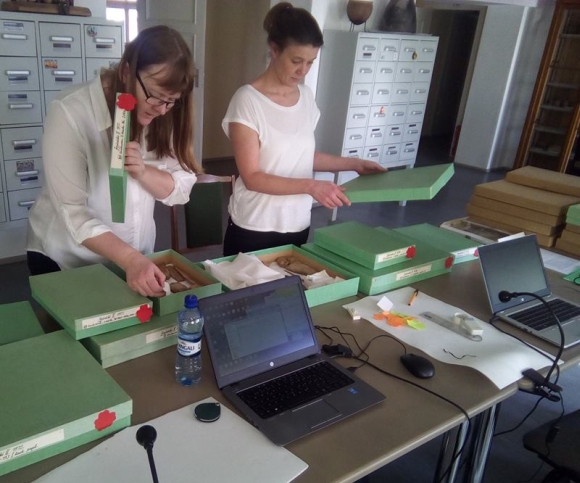
Norwegian lithics researchers (from left) Inger
Maria Berg-Hansen and Hege Damlien analysing collections at the
National History Museum of Latvia (photo: Mārcis Kalniņš)
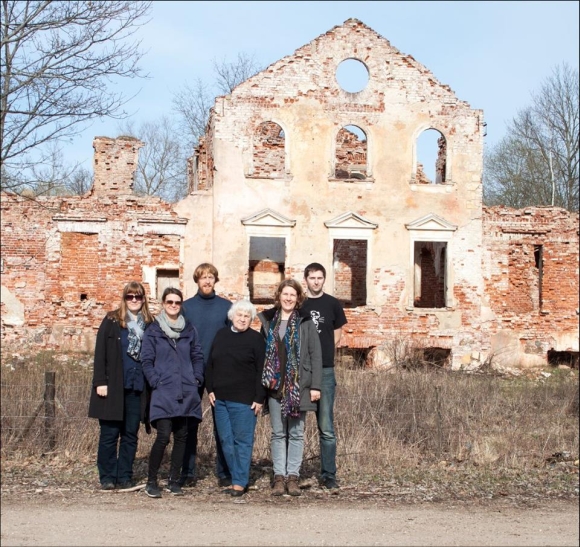
The lithic technology research group by the ruins of
the family manor of Count C. G. Sievers, initiator of Stone Age
research in Latvia, during the trip to the Zvejnieki complex of sites
(photo: Līga Palma)
04-22.04.2016
Survey of ironworks in the former Duchy of Courland and Semigallia
A group of experts from the Latvian side (Rūdolfs Brūzis, Mārīte
Jakovļeva, Dita Auziņa,
Viktorija Bebre and Inga Doniņa) have spent three weeks surveying the
16th-18th century ironworks in the territory of the former Duchy of
Courland and Semigallia - corresponding to the present-day regions of
Kurzeme, Zemgale and Sēlija. Norwegian experts Bernt Rundberget and Jan
Henning Larsen were also involved in the survey for a shorter period.
The survey included the following ironworks complexes:
Asari, Baldone, Birži, Dzelzsāmurs and the environs, Ēdas,
Engure, Kliņģi, Pelši, Skrunda, Turlava and Uguņi. Bearing in
mind the general absence of archaeological data, in the course of the
survey work the researchers mainly relied on data from written
historical sources. The recorded remains of ironworks include: charcoal
pits, structural remains, dams and networks of water channels. A large
number of iron ore and slag samples were collected. Local residents
also handed over items manufactured at the iron works, namely
cannonballs.
Hand-coring was carried out on several sites, and
prospection by georadar took place on two sites. Sites were surveyed by
total station and GPS.
The results of the survey are being brought
together in a database on the ironworks of the Duchy of Courland, and
information about the sites will be forwarded to the State Inspectorate
for Heritage Protection.
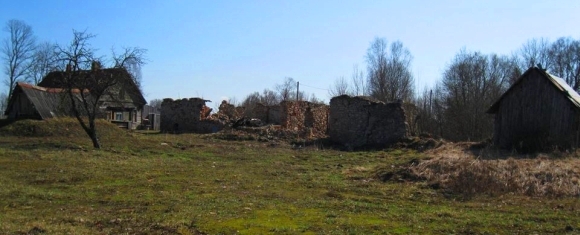
The Birži ironworks site.
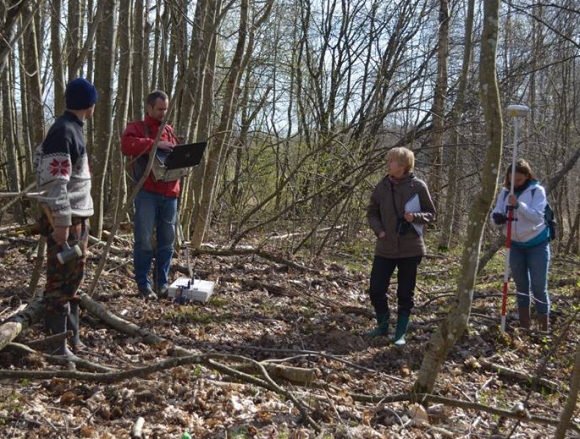
Georadar prospection and DGPS survey at the
Asari ironworks site.
28.02-03.03.2016
Visit by Norwegian iron production specialists in Riga
Researchers from the University of Oslo - Museum of Cultural History
specialising in iron production studies, Bernt
Rundberget and Jan Henning Larsen visited Riga to view archaeological
documentaion as well as samples of iron slag, bloom (raw iron) and iron
smelting furnace remains kept at the Repository of Archaeological
Material of the Institute of Latvian History, University of Latvia, the
Archaeology Department and of the National History Museum of Latvia and
the Archaeology Department of the Museum of History of Riga and
Navigation. In the course of the visit a large volume of material was
examined, relating to iron production from the beginning of the Iron
Age up to the Middle Ages. Samples for analysis were selected. Found to
be of particular interest were the Early Iron Age smelting furnaces at
Spietiņi, which differ from all the known furnace types in Norway.
Preserved slag samples from medieval towns turned out to
be smithing slags rather than slags from iron smelting.
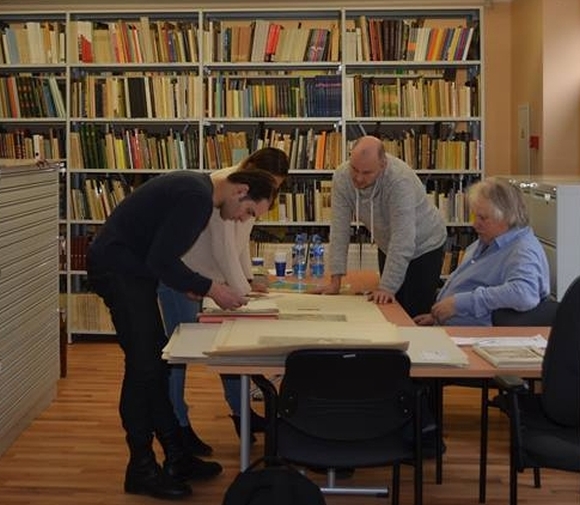
05.02.2016
Three papers on the theme of the project at the 74th University of
Latvia Conference
The Archaeology Session of the 74th University of Latvia Conference
included three papers discussing the theoretical aspects and first
results of the project. The session was held on 5 February 2016 at the
Faculty of History and Philosophy:
Andris Šnē. Technology
transfer in prehistoric societies: archaeological evidence of the
circulation of knowledge and skills
Mārcis Kalniņš.
Flint processing in dwelling 2 of the Sārnate settlement site
Dita Auziņa.
Iron production from prehistory up to the Early Modern Period -
research questions and trends
Conference
programme (in Latvian)
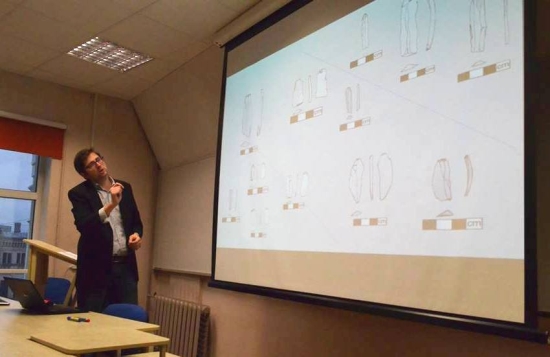
27.09-03.10.2015.
Visit to Norway by Latvian experts studying iron production
A group of archaeologists and a historian from
the University of
Latvia and the Institute of Latvian History at the University of
Latvia
went to Norway to visit our project partners from the University of
Oslo - Museum of Cultural
History. During the 7-day trip through Norway
we
visited archaeological sites of iron production from the Roman
period
up to the 18th century, took part in an archaeological reconstruction
of iron production and discussed research strategies for the project.
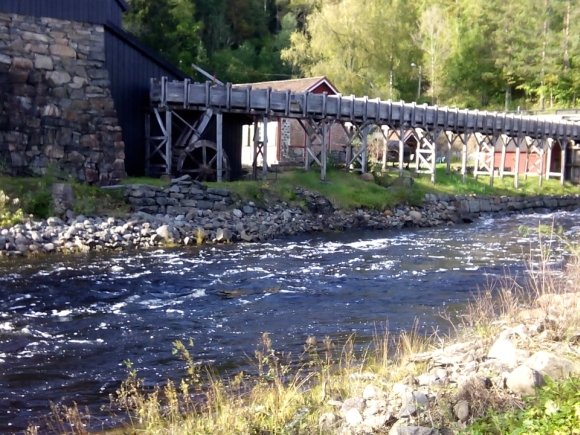
Nes Iron Works Museum, Tvedestrand. Almost intact
and completely preserved representation of an old iron works,
consisting of buildings, machinery and equipment, which date back to
the 17th, 18th and the 19th centuries. (Photo: Dita Auziņa)
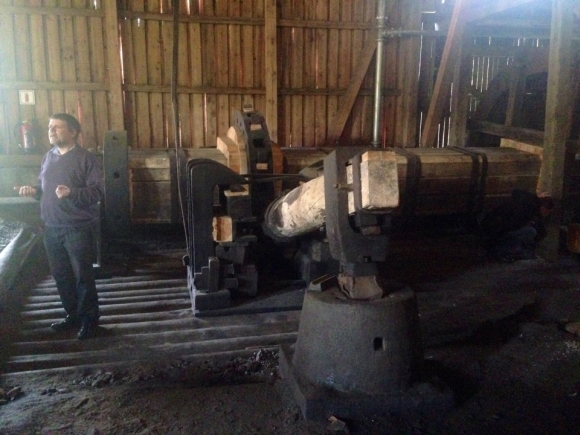
Gunnar Molden, researcher of Nes Iron Works
Museum, introduces the working principles of
the different hammers. (Photo: Dita Auziņa)
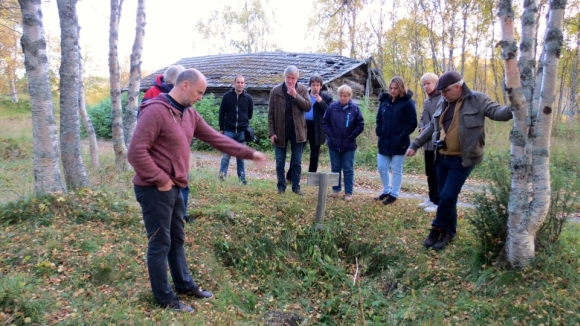
Burial field/bloomery site at Fekjå near
Geilo. Dr Bernt Rundberget presents a typical charcoal pit in the
landscape. (Photo: Inga Doniņa)
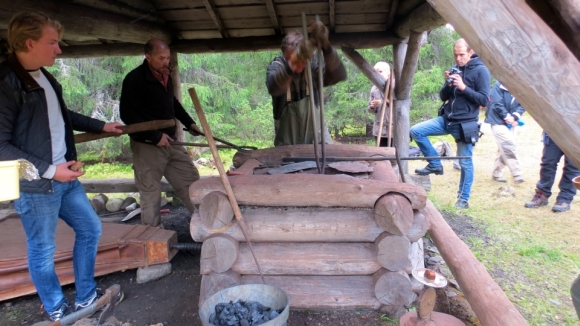
Reconstructed bloomery furnace, Dokkfløy.
Bog ore and charcoal are gradually added to
the furnace. (Photo: Inga Doniņa)
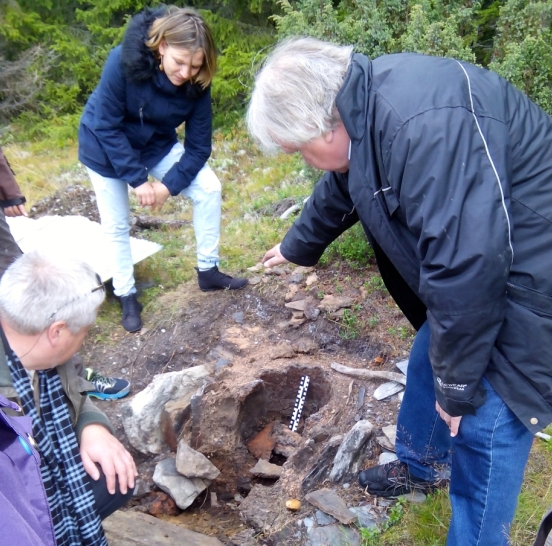
Bloomery furnace at Dokkfløy archaeological
site. (Photo: Andrejs Vasks)
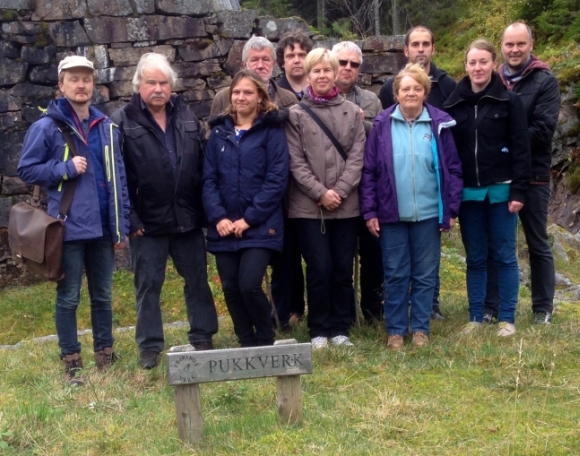
Participants of the study trip: (from left) Ingar
Mørkestøl Gundersen, Jan Henning Larsen, Dita
Auziņa, Andrejs Vasks, Andris Šnē, Mārīte Jakovļeva,
Armands Vijups, Viktorija bebre, Rūdolfs Brūzis, Inga Doniņa, Bernt
Rundberget
|
30.06.2015
Information
event in connection with
commencement of project implementation
Faculty of History and Philosophy,
Rm 513,
12 a.m.

The project was presented by the principal investigator Valdis
Bērziņš, along with project experts Mārīte Jakovļeva and
Andris
Šnē.
The event was attended by journalists from the
daily
newspaper "Latvijas Avīze", the news team of TV company LNT as
well as professional archaeologists from the Faculty of History and
Philosophy of the University of Latvia, the National History Museum of
Latvia, the State Inspection for Heritage Protection and other people
with an interest in this research.
Press
release (in Latvian)
In connection with this event Latvian Radio 1
broadcast
an interview
with V.Bērziņš, M. Jakovļeva and A.Šnē
(in Latvian)
in the "Zināmais nezināmā" programme on 30.06.2015.
Press article (in Latvian): V. Sprūde, "Pētīs
hercogistes laiku dzelzs manufaktūras", "Latvijas Avīze",
16.07.2015. |
01.06.2015
Project
implementation begins. |
01.06.2015
Partnership
agreement concluded. |
|
Project summary
The project focusses
on the technologies used for the processing of mineral
resources important in prehistory and in historical times, giving
particular attention to questions relating to the transfer of
technology between different societies and cultures.
A crucial raw material for tool-making was flint, and so special
methods for working this material developed over the millennia. The
production of iron from bog ore began in present-day Latvia in the
first centuries AD and continued in later periods, developing on a
large scale during the time of the Duchy of Courland.
With the participation
of Norwegian specialists, flint-working in the Stone Age and the
development of iron production technologies in present-day Latvia from
the period up to the early modern period is examined from the
perspective of technology transfer. Technical
analysis is undertaken on flint tools; archaeological excavation takes
place at the site of an ironworks; an ancient iron smelting furnace is
reconstructed; the results of the study are brought together in
international scholarly publications.
The project will contribute to the general understanding of
technologies and their development in Northern Europe in the
pre-industrial age.
Essential data
- Project
no. NFI/R/2014/062, Technology
transfer in the processing of mineral resources in earlier times
- The project is
co-financed by the European Economic
Area
Financial Mechanism and the Norwegian Financial Mechanism 2009-2014
Programme LV05 ‘Research and Scholarships’.
- Implementation
period:
1 June 2015 - 30 April 2017
Project
promoter: University
of Latvia
(project implemented at the Faculty of History and Philosophy and the
Institute of Latvian History)
Partner
1: University of Oslo -
Museum of Cultural History
Project
total costs:
€ 480850.00
Allocation
from Norway Grants: €
396701.00 (82.5%)
National
co-financing: € 48085.00
(10%)
Self
co-financing: €
36064.00 (7.5%)
The programme LV05
“Research and Scholarships”
is administered by the Ministry
of Education and Science of the Republic of Latvia in collaboration with
the State
Education Development Agency.
|
 LV | EN
LV | EN